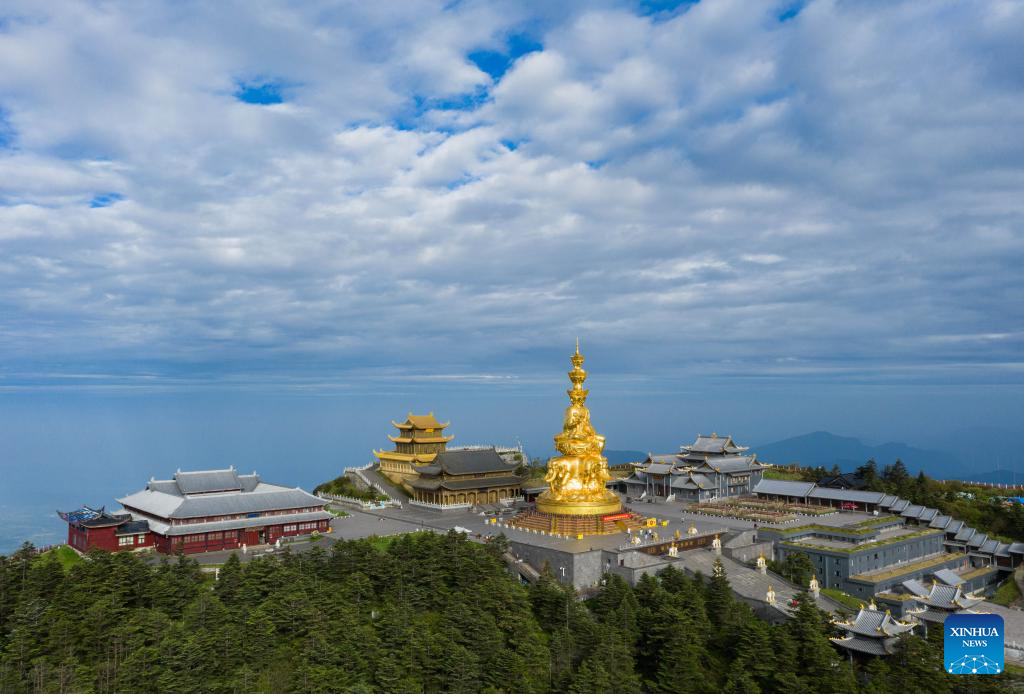
Aerial photo taken on June 5, 2022 shows the scenery of Mount Emei in southwest China's Sichuan Province.
Mount Emei, located in southwest China's Sichuan Province, is an area of striking scenic beauty, notable for its lofty mountain and lush vegetation. It is also of great spiritual and cultural significance, in which there are archaeological sites, important architecture, tombs, ritual spaces, and collections of cultural artefacts, including sculpture, stone inscriptions, calligraphy, and paintings, among other traditional arts. Mount Emei is known as one of the four holy mountains of Chinese Buddhism.
Carved out of a hillside in the 8th century, the Leshan Giant Buddha is an area of natural beauty into which the human element has been integrated with skill and subtlety. Facing the confluence of the Minjiang, Dadu and Qingyi rivers, the 71 meters tall Giant Buddha of Leshan is one of the most important cultural treasures of China.
With its natural and cultural values well interconnected, Mount Emei Scenic Area, including Leshan Giant Buddha Scenic Area, was inscribed on the UNESCO World Cultural and Natural Heritage List in 1996. (Xinhua/Jiang Hongjing)
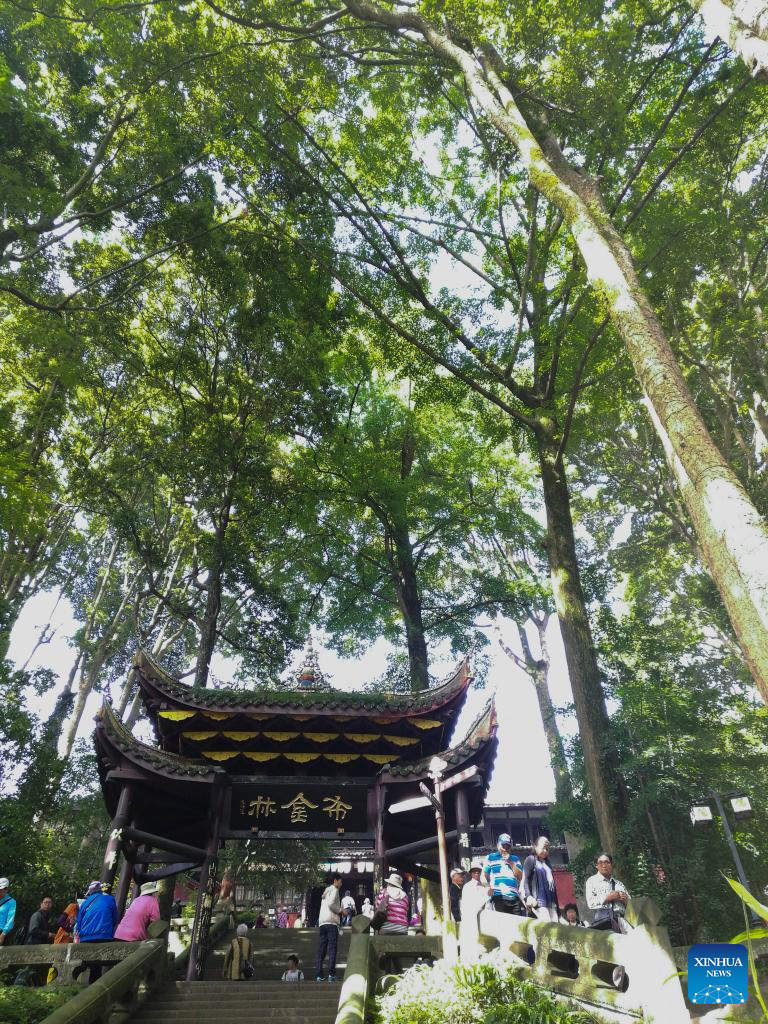
Tourists visit the scenic area of Mount Emei in southwest China's Sichuan Province, May 16, 2022.
Mount Emei, located in southwest China's Sichuan Province, is an area of striking scenic beauty, notable for its lofty mountain and lush vegetation. It is also of great spiritual and cultural significance, in which there are archaeological sites, important architecture, tombs, ritual spaces, and collections of cultural artefacts, including sculpture, stone inscriptions, calligraphy, and paintings, among other traditional arts. Mount Emei is known as one of the four holy mountains of Chinese Buddhism.
Carved out of a hillside in the 8th century, the Leshan Giant Buddha is an area of natural beauty into which the human element has been integrated with skill and subtlety. Facing the confluence of the Minjiang, Dadu and Qingyi rivers, the 71 meters tall Giant Buddha of Leshan is one of the most important cultural treasures of China.
With its natural and cultural values well interconnected, Mount Emei Scenic Area, including Leshan Giant Buddha Scenic Area, was inscribed on the UNESCO World Cultural and Natural Heritage List in 1996. (Xinhua/Jiang Hongjing)
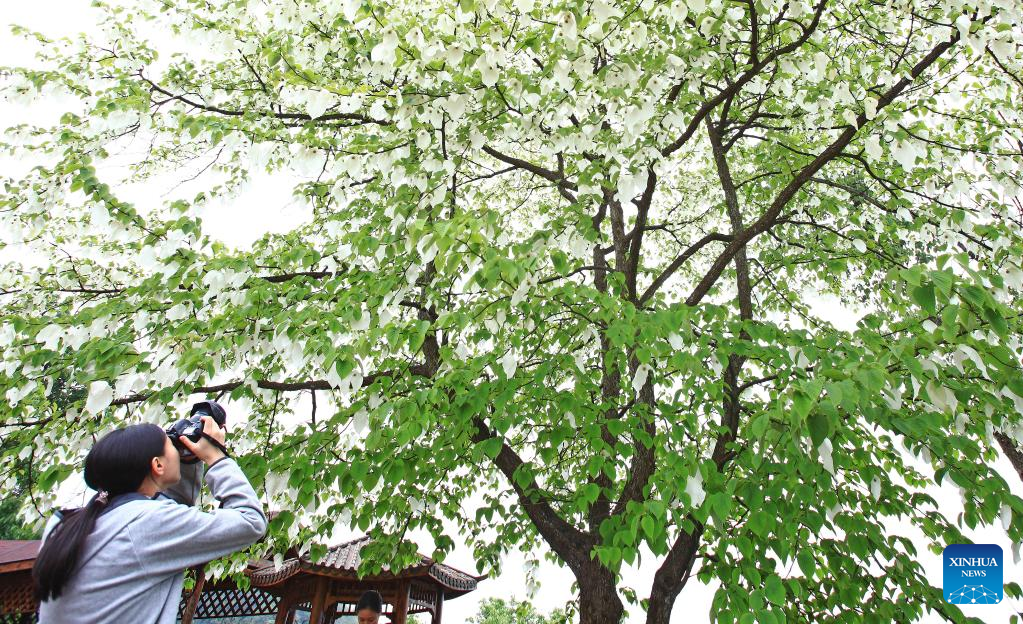
A tourist takes photos of a tree at the scenic area of Mount Emei in southwest China's Sichuan Province, April 17, 2020.
Mount Emei, located in southwest China's Sichuan Province, is an area of striking scenic beauty, notable for its lofty mountain and lush vegetation. It is also of great spiritual and cultural significance, in which there are archaeological sites, important architecture, tombs, ritual spaces, and collections of cultural artefacts, including sculpture, stone inscriptions, calligraphy, and paintings, among other traditional arts. Mount Emei is known as one of the four holy mountains of Chinese Buddhism.
Carved out of a hillside in the 8th century, the Leshan Giant Buddha is an area of natural beauty into which the human element has been integrated with skill and subtlety. Facing the confluence of the Minjiang, Dadu and Qingyi rivers, the 71 meters tall Giant Buddha of Leshan is one of the most important cultural treasures of China.
With its natural and cultural values well interconnected, Mount Emei Scenic Area, including Leshan Giant Buddha Scenic Area, was inscribed on the UNESCO World Cultural and Natural Heritage List in 1996. (Photo by Yuan Shihong/Xinhua)

Aerial photo taken on June 7, 2022 shows the interior view of a temple at Mount Emei in southwest China's Sichuan Province.
Mount Emei, located in southwest China's Sichuan Province, is an area of striking scenic beauty, notable for its lofty mountain and lush vegetation. It is also of great spiritual and cultural significance, in which there are archaeological sites, important architecture, tombs, ritual spaces, and collections of cultural artefacts, including sculpture, stone inscriptions, calligraphy, and paintings, among other traditional arts. Mount Emei is known as one of the four holy mountains of Chinese Buddhism.
Carved out of a hillside in the 8th century, the Leshan Giant Buddha is an area of natural beauty into which the human element has been integrated with skill and subtlety. Facing the confluence of the Minjiang, Dadu and Qingyi rivers, the 71 meters tall Giant Buddha of Leshan is one of the most important cultural treasures of China.
With its natural and cultural values well interconnected, Mount Emei Scenic Area, including Leshan Giant Buddha Scenic Area, was inscribed on the UNESCO World Cultural and Natural Heritage List in 1996. (Xinhua/Jiang Hongjing)

Aerial photo taken on June 5, 2022 shows the scenery of Mount Emei in southwest China's Sichuan Province.
Mount Emei, located in southwest China's Sichuan Province, is an area of striking scenic beauty, notable for its lofty mountain and lush vegetation. It is also of great spiritual and cultural significance, in which there are archaeological sites, important architecture, tombs, ritual spaces, and collections of cultural artefacts, including sculpture, stone inscriptions, calligraphy, and paintings, among other traditional arts. Mount Emei is known as one of the four holy mountains of Chinese Buddhism.
Carved out of a hillside in the 8th century, the Leshan Giant Buddha is an area of natural beauty into which the human element has been integrated with skill and subtlety. Facing the confluence of the Minjiang, Dadu and Qingyi rivers, the 71 meters tall Giant Buddha of Leshan is one of the most important cultural treasures of China.
With its natural and cultural values well interconnected, Mount Emei Scenic Area, including Leshan Giant Buddha Scenic Area, was inscribed on the UNESCO World Cultural and Natural Heritage List in 1996. (Xinhua/Jiang Hongjing)

A monk is seen at Mount Emei in southwest China's Sichuan Province, May 18, 2022.
Mount Emei, located in southwest China's Sichuan Province, is an area of striking scenic beauty, notable for its lofty mountain and lush vegetation. It is also of great spiritual and cultural significance, in which there are archaeological sites, important architecture, tombs, ritual spaces, and collections of cultural artefacts, including sculpture, stone inscriptions, calligraphy, and paintings, among other traditional arts. Mount Emei is known as one of the four holy mountains of Chinese Buddhism.
Carved out of a hillside in the 8th century, the Leshan Giant Buddha is an area of natural beauty into which the human element has been integrated with skill and subtlety. Facing the confluence of the Minjiang, Dadu and Qingyi rivers, the 71 meters tall Giant Buddha of Leshan is one of the most important cultural treasures of China.
With its natural and cultural values well interconnected, Mount Emei Scenic Area, including Leshan Giant Buddha Scenic Area, was inscribed on the UNESCO World Cultural and Natural Heritage List in 1996. (Xinhua/Jiang Hongjing)
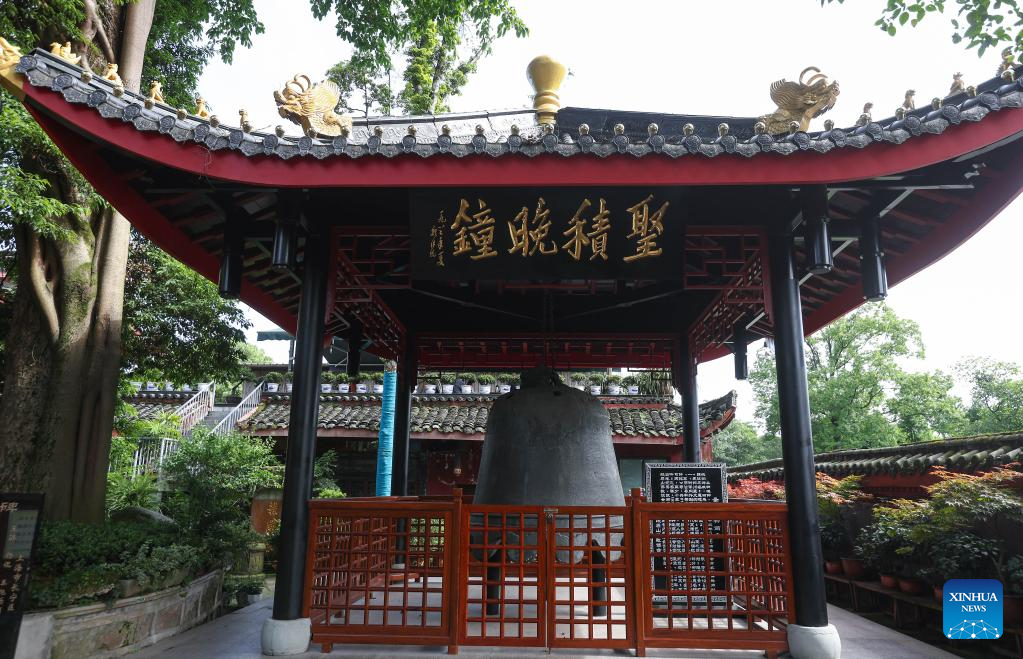
Photo taken on June 7, 2022 shows an ancient bell at Mount Emei in southwest China's Sichuan Province.
Mount Emei, located in southwest China's Sichuan Province, is an area of striking scenic beauty, notable for its lofty mountain and lush vegetation. It is also of great spiritual and cultural significance, in which there are archaeological sites, important architecture, tombs, ritual spaces, and collections of cultural artefacts, including sculpture, stone inscriptions, calligraphy, and paintings, among other traditional arts. Mount Emei is known as one of the four holy mountains of Chinese Buddhism.
Carved out of a hillside in the 8th century, the Leshan Giant Buddha is an area of natural beauty into which the human element has been integrated with skill and subtlety. Facing the confluence of the Minjiang, Dadu and Qingyi rivers, the 71 meters tall Giant Buddha of Leshan is one of the most important cultural treasures of China.
With its natural and cultural values well interconnected, Mount Emei Scenic Area, including Leshan Giant Buddha Scenic Area, was inscribed on the UNESCO World Cultural and Natural Heritage List in 1996. (Xinhua/Jiang Hongjing)

Photo taken on June 5, 2022 shows the scenery of Mount Emei in southwest China's Sichuan Province.
Mount Emei, located in southwest China's Sichuan Province, is an area of striking scenic beauty, notable for its lofty mountain and lush vegetation. It is also of great spiritual and cultural significance, in which there are archaeological sites, important architecture, tombs, ritual spaces, and collections of cultural artefacts, including sculpture, stone inscriptions, calligraphy, and paintings, among other traditional arts. Mount Emei is known as one of the four holy mountains of Chinese Buddhism.
Carved out of a hillside in the 8th century, the Leshan Giant Buddha is an area of natural beauty into which the human element has been integrated with skill and subtlety. Facing the confluence of the Minjiang, Dadu and Qingyi rivers, the 71 meters tall Giant Buddha of Leshan is one of the most important cultural treasures of China.
With its natural and cultural values well interconnected, Mount Emei Scenic Area, including Leshan Giant Buddha Scenic Area, was inscribed on the UNESCO World Cultural and Natural Heritage List in 1996. (Xinhua/Jiang Hongjing)

Combo photo shows cultural relics of Mount Emei in southwest China's Sichuan Province, June 6, 2022.
Mount Emei, located in southwest China's Sichuan Province, is an area of striking scenic beauty, notable for its lofty mountain and lush vegetation. It is also of great spiritual and cultural significance, in which there are archaeological sites, important architecture, tombs, ritual spaces, and collections of cultural artefacts, including sculpture, stone inscriptions, calligraphy, and paintings, among other traditional arts. Mount Emei is known as one of the four holy mountains of Chinese Buddhism.
Carved out of a hillside in the 8th century, the Leshan Giant Buddha is an area of natural beauty into which the human element has been integrated with skill and subtlety. Facing the confluence of the Minjiang, Dadu and Qingyi rivers, the 71 meters tall Giant Buddha of Leshan is one of the most important cultural treasures of China.
With its natural and cultural values well interconnected, Mount Emei Scenic Area, including Leshan Giant Buddha Scenic Area, was inscribed on the UNESCO World Cultural and Natural Heritage List in 1996. (Xinhua/Jiang Hongjing)
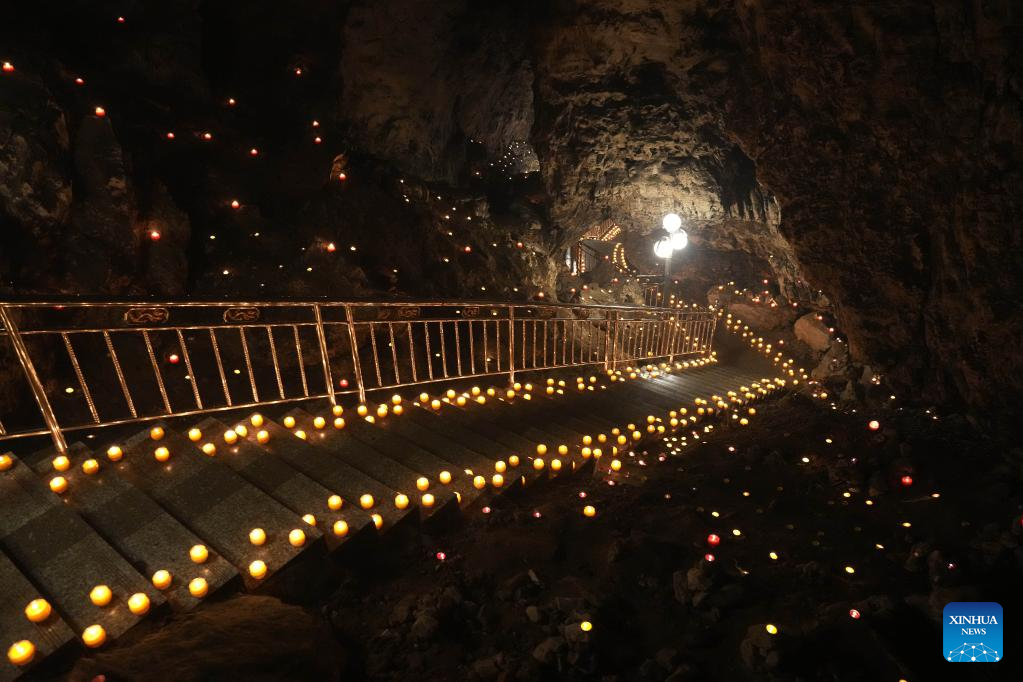
Photo taken on April 15, 2022 shows the scenery of Mount Emei in southwest China's Sichuan Province.
Mount Emei, located in southwest China's Sichuan Province, is an area of striking scenic beauty, notable for its lofty mountain and lush vegetation. It is also of great spiritual and cultural significance, in which there are archaeological sites, important architecture, tombs, ritual spaces, and collections of cultural artefacts, including sculpture, stone inscriptions, calligraphy, and paintings, among other traditional arts. Mount Emei is known as one of the four holy mountains of Chinese Buddhism.
Carved out of a hillside in the 8th century, the Leshan Giant Buddha is an area of natural beauty into which the human element has been integrated with skill and subtlety. Facing the confluence of the Minjiang, Dadu and Qingyi rivers, the 71 meters tall Giant Buddha of Leshan is one of the most important cultural treasures of China.
With its natural and cultural values well interconnected, Mount Emei Scenic Area, including Leshan Giant Buddha Scenic Area, was inscribed on the UNESCO World Cultural and Natural Heritage List in 1996. (Xinhua/Jiang Hongjing)
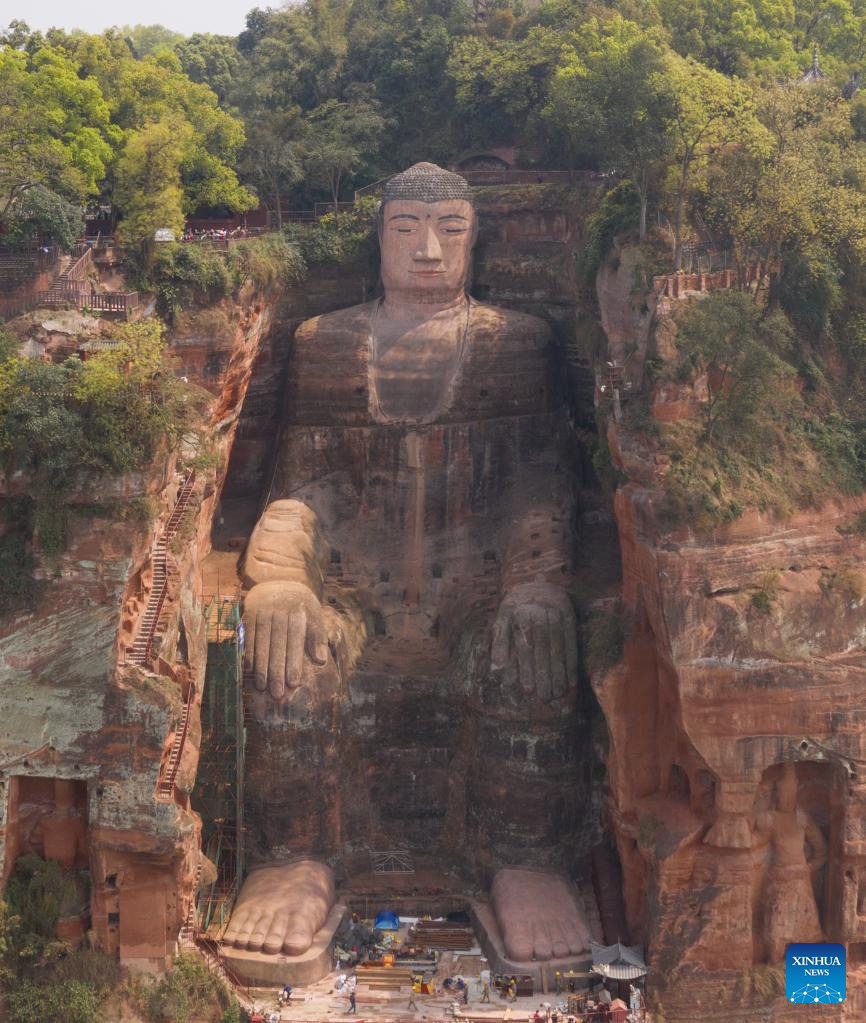
Aerial photo taken on March 29, 2019 shows the Leshan Giant Buddha in southwest China's Sichuan Province.
Mount Emei, located in southwest China's Sichuan Province, is an area of striking scenic beauty, notable for its lofty mountain and lush vegetation. It is also of great spiritual and cultural significance, in which there are archaeological sites, important architecture, tombs, ritual spaces, and collections of cultural artefacts, including sculpture, stone inscriptions, calligraphy, and paintings, among other traditional arts. Mount Emei is known as one of the four holy mountains of Chinese Buddhism.
Carved out of a hillside in the 8th century, the Leshan Giant Buddha is an area of natural beauty into which the human element has been integrated with skill and subtlety. Facing the confluence of the Minjiang, Dadu and Qingyi rivers, the 71 meters tall Giant Buddha of Leshan is one of the most important cultural treasures of China.
With its natural and cultural values well interconnected, Mount Emei Scenic Area, including Leshan Giant Buddha Scenic Area, was inscribed on the UNESCO World Cultural and Natural Heritage List in 1996. (Xinhua/Jiang Hongjing)
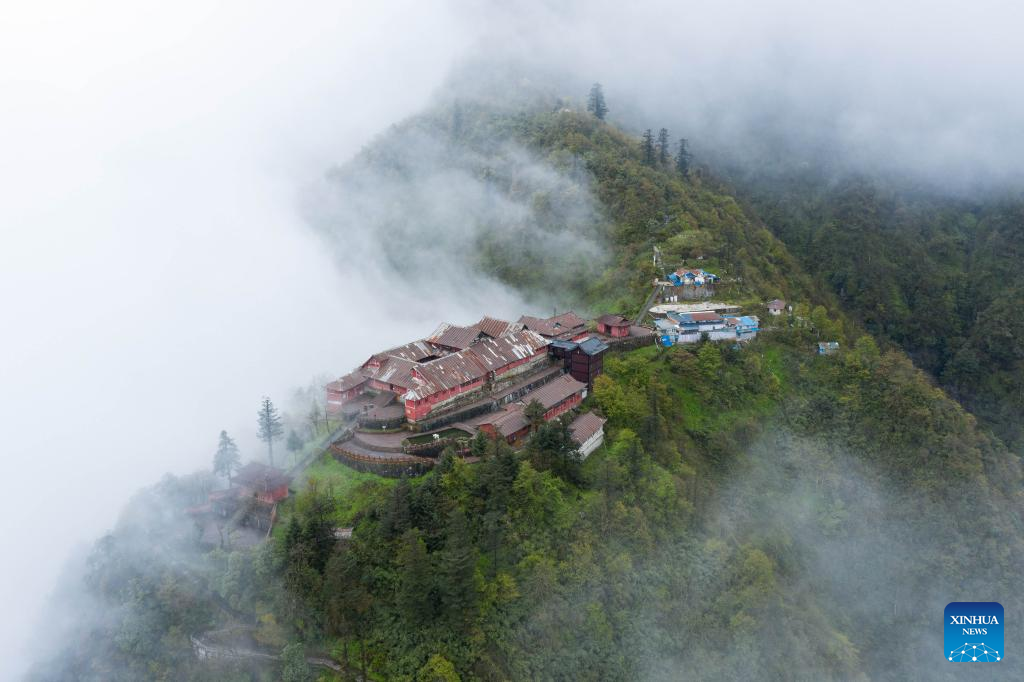
Aerial photo taken on April 15, 2022 shows the scenery of Mount Emei in southwest China's Sichuan Province.
Mount Emei, located in southwest China's Sichuan Province, is an area of striking scenic beauty, notable for its lofty mountain and lush vegetation. It is also of great spiritual and cultural significance, in which there are archaeological sites, important architecture, tombs, ritual spaces, and collections of cultural artefacts, including sculpture, stone inscriptions, calligraphy, and paintings, among other traditional arts. Mount Emei is known as one of the four holy mountains of Chinese Buddhism.
Carved out of a hillside in the 8th century, the Leshan Giant Buddha is an area of natural beauty into which the human element has been integrated with skill and subtlety. Facing the confluence of the Minjiang, Dadu and Qingyi rivers, the 71 meters tall Giant Buddha of Leshan is one of the most important cultural treasures of China.
With its natural and cultural values well interconnected, Mount Emei Scenic Area, including Leshan Giant Buddha Scenic Area, was inscribed on the UNESCO World Cultural and Natural Heritage List in 1996. (Xinhua/Jiang Hongjing)
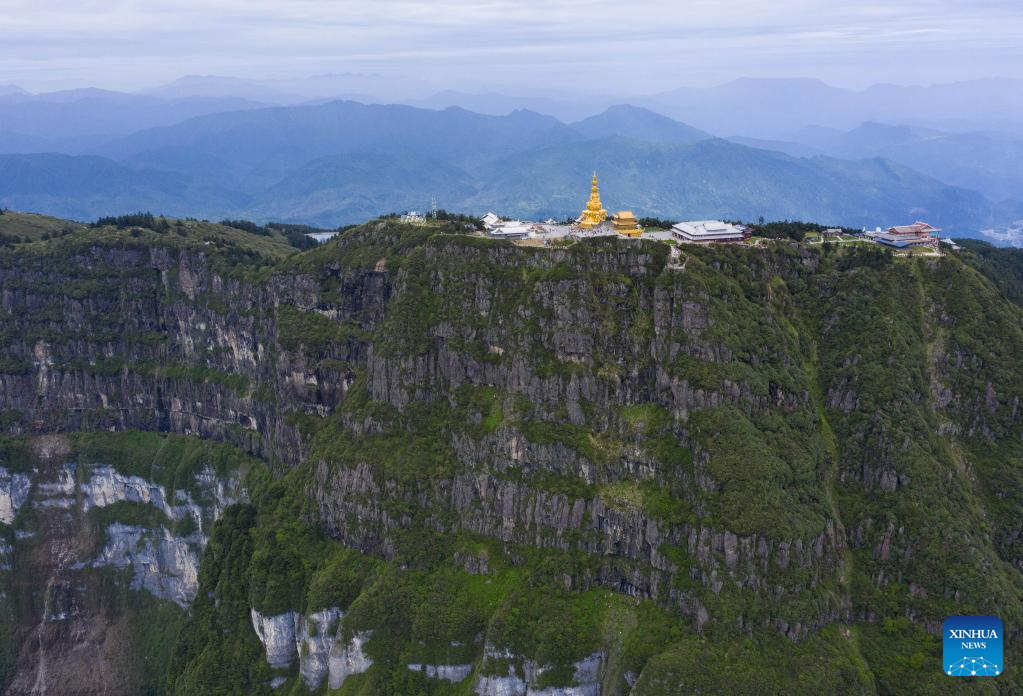
Aerial photo taken on June 6, 2022 shows the scenery of Mount Emei in southwest China's Sichuan Province.
Mount Emei, located in southwest China's Sichuan Province, is an area of striking scenic beauty, notable for its lofty mountain and lush vegetation. It is also of great spiritual and cultural significance, in which there are archaeological sites, important architecture, tombs, ritual spaces, and collections of cultural artefacts, including sculpture, stone inscriptions, calligraphy, and paintings, among other traditional arts. Mount Emei is known as one of the four holy mountains of Chinese Buddhism.
Carved out of a hillside in the 8th century, the Leshan Giant Buddha is an area of natural beauty into which the human element has been integrated with skill and subtlety. Facing the confluence of the Minjiang, Dadu and Qingyi rivers, the 71 meters tall Giant Buddha of Leshan is one of the most important cultural treasures of China.
With its natural and cultural values well interconnected, Mount Emei Scenic Area, including Leshan Giant Buddha Scenic Area, was inscribed on the UNESCO World Cultural and Natural Heritage List in 1996. (Xinhua/Jiang Hongjing)
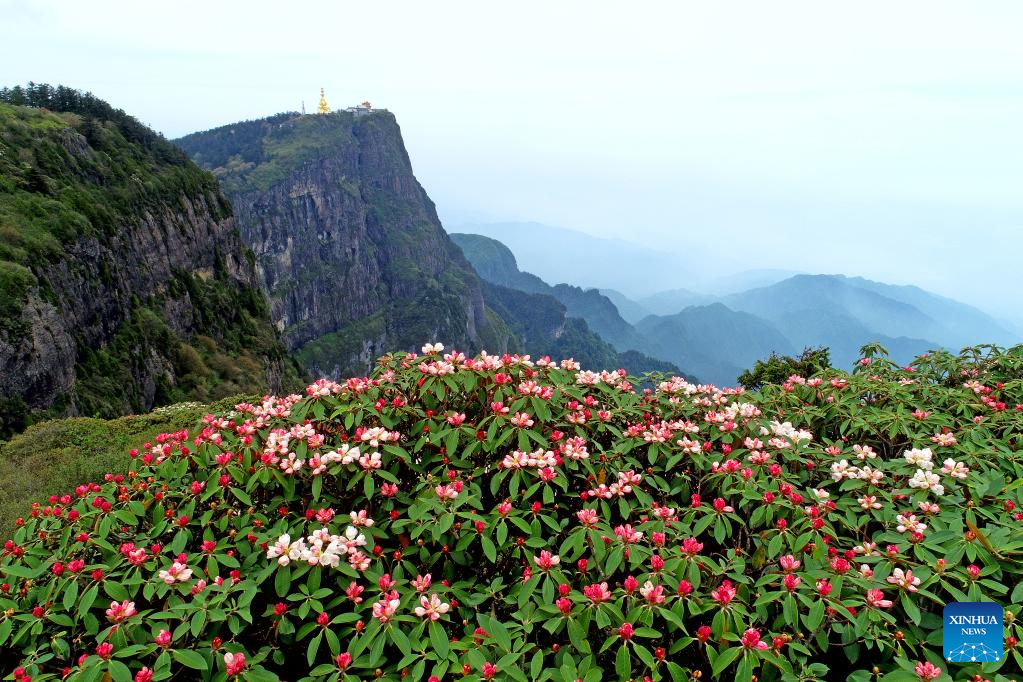
Photo taken on May 23, 2020 shows the scenery of Mount Emei in southwest China's Sichuan Province.
Mount Emei, located in southwest China's Sichuan Province, is an area of striking scenic beauty, notable for its lofty mountain and lush vegetation. It is also of great spiritual and cultural significance, in which there are archaeological sites, important architecture, tombs, ritual spaces, and collections of cultural artefacts, including sculpture, stone inscriptions, calligraphy, and paintings, among other traditional arts. Mount Emei is known as one of the four holy mountains of Chinese Buddhism.
Carved out of a hillside in the 8th century, the Leshan Giant Buddha is an area of natural beauty into which the human element has been integrated with skill and subtlety. Facing the confluence of the Minjiang, Dadu and Qingyi rivers, the 71 meters tall Giant Buddha of Leshan is one of the most important cultural treasures of China.
With its natural and cultural values well interconnected, Mount Emei Scenic Area, including Leshan Giant Buddha Scenic Area, was inscribed on the UNESCO World Cultural and Natural Heritage List in 1996. (Photo by Yuan Shihong/Xinhua)
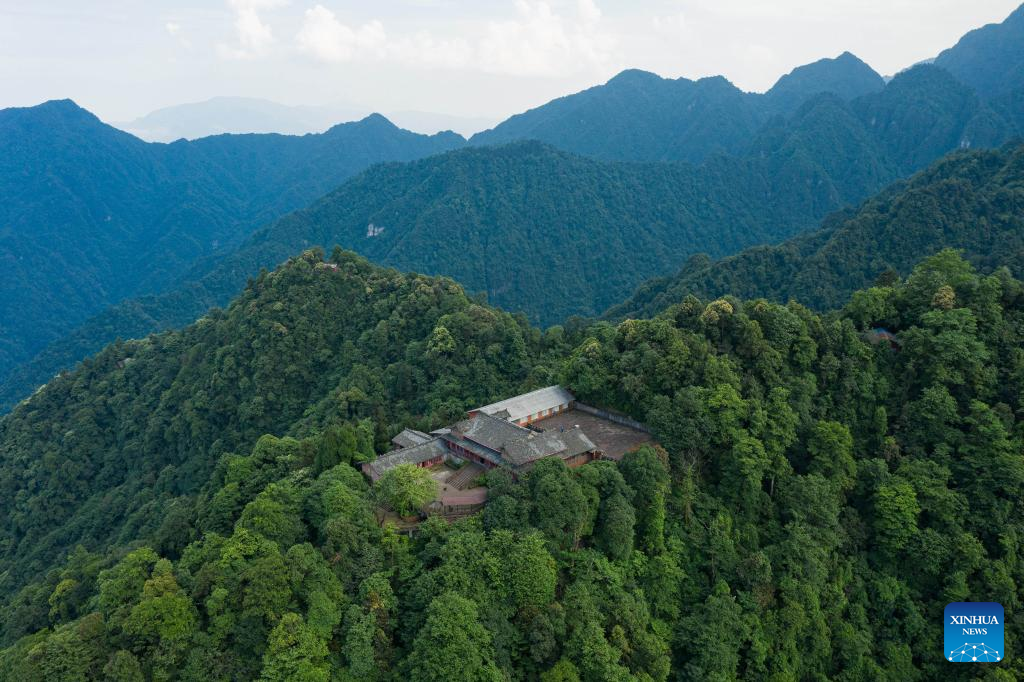
Aerial photo taken on June 7, 2022 shows the scenery of Mount Emei in southwest China's Sichuan Province.
Mount Emei, located in southwest China's Sichuan Province, is an area of striking scenic beauty, notable for its lofty mountain and lush vegetation. It is also of great spiritual and cultural significance, in which there are archaeological sites, important architecture, tombs, ritual spaces, and collections of cultural artefacts, including sculpture, stone inscriptions, calligraphy, and paintings, among other traditional arts. Mount Emei is known as one of the four holy mountains of Chinese Buddhism.
Carved out of a hillside in the 8th century, the Leshan Giant Buddha is an area of natural beauty into which the human element has been integrated with skill and subtlety. Facing the confluence of the Minjiang, Dadu and Qingyi rivers, the 71 meters tall Giant Buddha of Leshan is one of the most important cultural treasures of China.
With its natural and cultural values well interconnected, Mount Emei Scenic Area, including Leshan Giant Buddha Scenic Area, was inscribed on the UNESCO World Cultural and Natural Heritage List in 1996. (Xinhua/Jiang Hongjing)
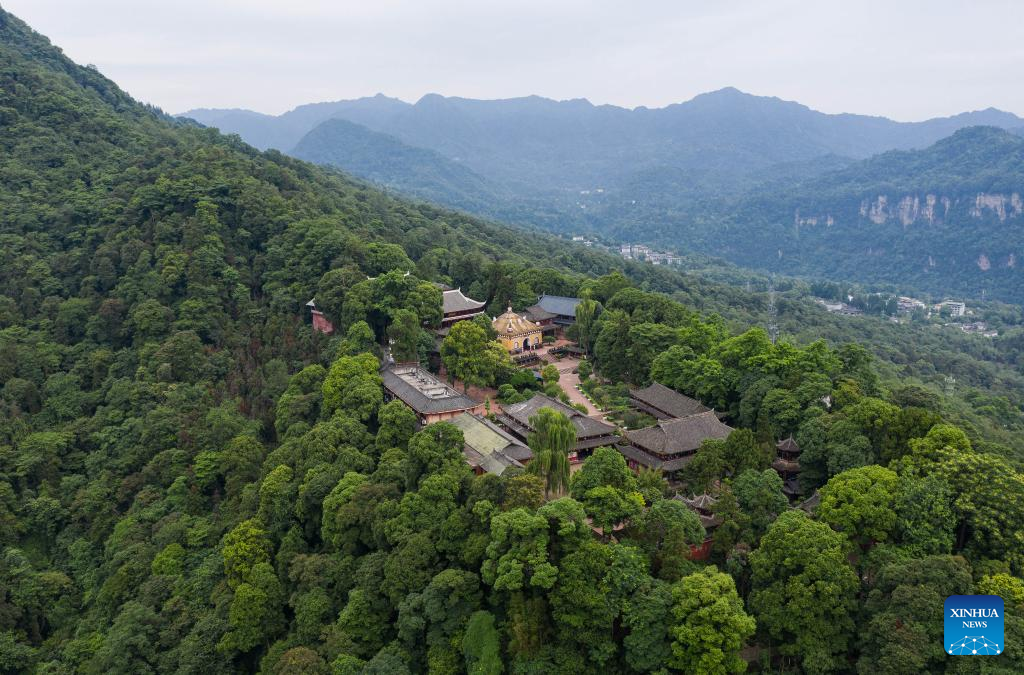
Aerial photo taken on June 6, 2022 shows the scenery of Mount Emei in southwest China's Sichuan Province.
Mount Emei, located in southwest China's Sichuan Province, is an area of striking scenic beauty, notable for its lofty mountain and lush vegetation. It is also of great spiritual and cultural significance, in which there are archaeological sites, important architecture, tombs, ritual spaces, and collections of cultural artefacts, including sculpture, stone inscriptions, calligraphy, and paintings, among other traditional arts. Mount Emei is known as one of the four holy mountains of Chinese Buddhism.
Carved out of a hillside in the 8th century, the Leshan Giant Buddha is an area of natural beauty into which the human element has been integrated with skill and subtlety. Facing the confluence of the Minjiang, Dadu and Qingyi rivers, the 71 meters tall Giant Buddha of Leshan is one of the most important cultural treasures of China.
With its natural and cultural values well interconnected, Mount Emei Scenic Area, including Leshan Giant Buddha Scenic Area, was inscribed on the UNESCO World Cultural and Natural Heritage List in 1996. (Xinhua/Jiang Hongjing)



